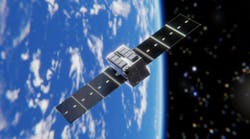By John Rhea
SYRACUSE, N.Y. — Engineers at Lockheed Martin Naval Electronics & Surveillance Systems in Syracuse, N.Y., are rendering one of their fixed-site radar systems mobile at least in part by upgrading its electronics with the Motorola PowerPC microprocessor.
The new radar, designated the TPS-117 (the "T" stands for transportable), is 80 percent common at the component level with the Air Force's AN/FPS-117 (the "F" stands for fixed). Technicians can transport the TPS-117 in an Air Force C-17 cargo jet.
The new system, derived from an L-band tactical radar long used by the U.S. Air Force, weighs half as much (17,000 pounds vs. 35,000 pounds) and is about $2 million cheaper, says Richard Schubert, vice president for radar/sensor systems at the Lockheed Martin Syracuse facility. Moreover, it is becoming more digital, starting with the replacement of the traditionally analog receivers and using monopulse processing.
Although most of the system's weight reduction comes from light structural components such as the pedestal, new electronics have improved system reliability to where one radar can deploy at a remote site without a "hot spare" as a backup, company officials say. Lockheed Martin officials are claiming a system mean time between failure of 1,500 hours and a mean time to repair of 30 minutes.
The radar is already in production for direct foreign sales, with four being delivered to Australia under a $90 million contract and six to Brazil for $82 million.
Next in line to receive the transportable radars are Jordan, South Korea, and Taiwan, Schubert says. These transactions will go through the U.S. Department of Defense's Foreign Military Sales program, when the radar will receive the AN/ designation in about three to six months.
The AN/FPS-117 fixed site radar has been operational with the U.S. Alaskan Air Command at 13 sites since 1987, and the Air Force and Lockheed Martin claim it has reduced manning requirements. The transportable and fixed-site models can operate remotely with nobody on site.
The use of L band (1,215-1,400 MHz) represents a tradeoff. This frequency band is best suited for picking out targets in a cluttered environment, Schubert says. Its disadvantage is its bulky equipment. This is where the advanced electronics can help.
The post-Cold War environment of responding to localized threats drives the requirement for transportable tactical radars, he adds, but the TPS-117 is intended solely to counter aircraft threats, not missiles. Upgrading it to meet those threats will require further development.
As a bonus, the radars also are appropriate for airport surveillance and civil air traffic control, Lockheed Martin officials say. Romania and Croatia are already using their fixed-site radars for that purpose, and Brazil will use its new TPS for civil purposes. The radar has a range of 256 nautical miles.



